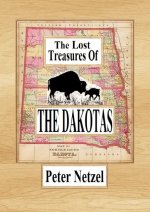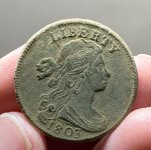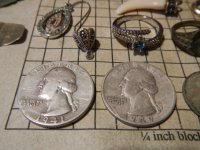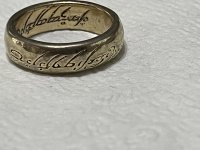You are using an out of date browser. It may not display this or other websites correctly.
You should upgrade or use an alternative browser.
You should upgrade or use an alternative browser.
Slain Miser's Cache
- Thread starter Tiredman
- Start date
- Thread starter
- #2
The lead:
THE CITIZEN-REPUBLICAN
Scotland, Bon Homme County, S.D.
November 21, 1907
STRANGERS SEEK BURIED TREASURE OF SLAIN HERMIT
–––––––––––
Mysterious Persons Are Nightly Digging Around Farm In Search Of Wealth
–––––––––––
Clark, S.D., Nov. 19.—The mysterious murder of Francis Marion Brown, at his home in the western part of Codington County, a short distance east of Clark, in which he had lived for a period of twenty-four years, has been followed by one of the strangest treasure hunts on record.
Brown was wealthy, and those familiar with his affairs are confident that when he died he had from $30,000 to $60,000 in cash. He had not the slightest confidence in banks. And, as only a few hundred dollars have been found on deposit in a bank, it is fully believed that tens of thousands of dollars have been buried on his farm.
It is in the hope of finding this hidden wealth that certain mysterious parties are nightly digging around the Brown farm. Neighboring farmers tell of mysterious figures flitting about at night, and enough is known to make it certain that a systematic search is being made for the hidden gold.
Brown was a bachelor; from the time in taking up his residence on the farm until he was murdered, he lived alone. He was somewhat eccentric, but jovial and pleasant.
FEARED AN ATTACK.
For years before his tragic death he was aware that he was in danger of being waylaid and robbed, but he was no coward. And, to those friends who cautioned him to be careful, he said: "I know I am being watched, but they will not get me. I will get them."
But he never stated by whom he thought he was being watched. Had he done so, the authorities might have less difficulty in running down his murderers. It is known that Brown was accustomed to carrying two pocketbooks; but these were not found by the authorities. It is not thought likely, however, that he carried more than a few hundred dollars in the pocketbooks, and that the remainder of his great wealth, outside of the few hundred dollars in the bank, was buried on his farm. It is not believed that the men who murdered him succeeded in finding this hidden wealth, as their search necessarily would be a hurried one.
TREASURE IS BURIED.
Because of this belief, there appears little doubt that Brown's “cache” of gold yet remains on his farm; and the mysterious persons who are reported to haunt the farm nightly evidently have strong hopes of finding the money.
The dead hermit was born in St. Louis County, Missouri, in September, 1858, and moved with his parents to McPherson County, Kansas, when in his teens. Nearly a quarter of a century ago, he came to what now is South Dakota and located on the farm where he was murdered. He had always been a money-maker, having acquired the habit when a mere boy. He used to act as banker and collector for his playmates. discounting and collecting small accounts, and loaning money to his chums on an interest basis.
When he arrived in Dakota he had $1,000 in cash. From the time of his arrival until his death, he had never visited or been visited by any of his relatives. The old hermit is survived by six brothers and sisters, as follows: William Brown, Woodward, Okla.; Oscar Brown, Canton, Kas.; Bentley Brown, Hennessy, Okla.; Belle Powell, Haskey, Okla.; Mary Switzer, McPherson, Kas.; Martha Welch, Haskell, Okla.
The murdered man left personal property valued at many thousand of dollars. This consisted of 160 acres of land about 1,800 bushels of grain; five head of valuable horses; three head of cattle; about sixty-five head of 200-pound hogs; and other farm and personal property.
THE CITIZEN-REPUBLICAN
Scotland, Bon Homme County, S.D.
November 21, 1907
STRANGERS SEEK BURIED TREASURE OF SLAIN HERMIT
–––––––––––
Mysterious Persons Are Nightly Digging Around Farm In Search Of Wealth
–––––––––––
Clark, S.D., Nov. 19.—The mysterious murder of Francis Marion Brown, at his home in the western part of Codington County, a short distance east of Clark, in which he had lived for a period of twenty-four years, has been followed by one of the strangest treasure hunts on record.
Brown was wealthy, and those familiar with his affairs are confident that when he died he had from $30,000 to $60,000 in cash. He had not the slightest confidence in banks. And, as only a few hundred dollars have been found on deposit in a bank, it is fully believed that tens of thousands of dollars have been buried on his farm.
It is in the hope of finding this hidden wealth that certain mysterious parties are nightly digging around the Brown farm. Neighboring farmers tell of mysterious figures flitting about at night, and enough is known to make it certain that a systematic search is being made for the hidden gold.
Brown was a bachelor; from the time in taking up his residence on the farm until he was murdered, he lived alone. He was somewhat eccentric, but jovial and pleasant.
FEARED AN ATTACK.
For years before his tragic death he was aware that he was in danger of being waylaid and robbed, but he was no coward. And, to those friends who cautioned him to be careful, he said: "I know I am being watched, but they will not get me. I will get them."
But he never stated by whom he thought he was being watched. Had he done so, the authorities might have less difficulty in running down his murderers. It is known that Brown was accustomed to carrying two pocketbooks; but these were not found by the authorities. It is not thought likely, however, that he carried more than a few hundred dollars in the pocketbooks, and that the remainder of his great wealth, outside of the few hundred dollars in the bank, was buried on his farm. It is not believed that the men who murdered him succeeded in finding this hidden wealth, as their search necessarily would be a hurried one.
TREASURE IS BURIED.
Because of this belief, there appears little doubt that Brown's “cache” of gold yet remains on his farm; and the mysterious persons who are reported to haunt the farm nightly evidently have strong hopes of finding the money.
The dead hermit was born in St. Louis County, Missouri, in September, 1858, and moved with his parents to McPherson County, Kansas, when in his teens. Nearly a quarter of a century ago, he came to what now is South Dakota and located on the farm where he was murdered. He had always been a money-maker, having acquired the habit when a mere boy. He used to act as banker and collector for his playmates. discounting and collecting small accounts, and loaning money to his chums on an interest basis.
When he arrived in Dakota he had $1,000 in cash. From the time of his arrival until his death, he had never visited or been visited by any of his relatives. The old hermit is survived by six brothers and sisters, as follows: William Brown, Woodward, Okla.; Oscar Brown, Canton, Kas.; Bentley Brown, Hennessy, Okla.; Belle Powell, Haskey, Okla.; Mary Switzer, McPherson, Kas.; Martha Welch, Haskell, Okla.
The murdered man left personal property valued at many thousand of dollars. This consisted of 160 acres of land about 1,800 bushels of grain; five head of valuable horses; three head of cattle; about sixty-five head of 200-pound hogs; and other farm and personal property.
Top Member Reactions
-
 2591
2591 -
 1143
1143 -
 1031
1031 -
 903
903 -
 870
870 -
 838
838 -
 792
792 -
 666
666 -
 664
664 -
 630
630 -
 473
473 -
 472
472 -
 467
467 -
 462
462 -
 459
459 -
 440
440 -
 416
416 -
 414
414 -
O
392
-
 380
380
Users who are viewing this thread
Total: 2 (members: 0, guests: 2)
Latest Discussions
-
-
"GLORY DAYS" for Ol' timers thread... let's have fun & share..!
- Latest: DizzyDigger







